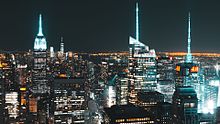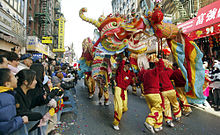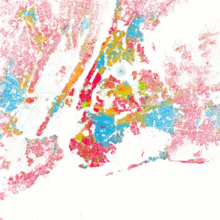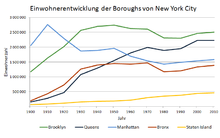New York City
![]()
This article is about the city. For the band, see New York City (band).
New York City (AE: [nuːˈjɔɹk ˈsɪɾi], short: New York, German veraltet: Neuyork or Newyork, abbreviation: NYC) is a cosmopolitan city on the east coast of the United States. It is located in the state of New York and is the most populous city in the United States with about 8.3 million inhabitants.
The metropolitan region of New York with 19 million inhabitants is one of the most important economic areas and trading centres in the world, the headquarters of many international corporations and organisations such as the United Nations, and an important sea and inland port on the American East Coast and the Hudson. The city enjoys a world reputation in the arts and culture with its large number of attractions, 500 galleries, some 200 museums, more than 150 theatres and more than 18,000 restaurants, and receives some 50 million visitors each year, nearly 12 million of them from abroad. According to Forbes Magazine, New York City is the city with the highest cost of living in the United States, as well as one of the most expensive cities in the world.
The city is generally considered to be one of the most important centers of diplomacy in the world. Together with Geneva (ICRC and European headquarters of the UN), Basel (Bank for International Settlements) and Strasbourg (Council of Europe), New York City is one of the few cities in the world to host one of the most important international organizations, without being the capital of a country.
After Giovanni da Verrazzano explored the area of present-day New York in 1524 and Henry Hudson in 1609, Dutch merchants settled on the southern tip of Manna-Hatta Island beginning in 1610 and soon after on the western tip of Long Island, now Brooklyn. According to legend, in 1626 Peter Minuit bought the island of "Manna-hatta" from the natives, probably Lenni-Lenape Indians, for goods worth 60 guilders. The settlement was named Nieuw Amsterdam and was initially the capital of the colony of Nieuw Nederland until it was conquered by the British in 1664, giving the city the name it has had ever since. Its rise as a cosmopolitan city began in 1825 with the completion of the Erie Canal.
The New York-Newark-Jersey City metropolitan region generated $1.718 trillion in economic output in 2017. Among the world's cities, it ranks second behind Tokyo and would be counted as a separate state among the world's 20 largest economies.
Geography
Geographical position
New York City has expanded from the island of Manhattan, which is now its center, projecting as a pointed promontory between the Hudson and East Rivers. It lies in latitude 40.42° north and longitude 74.00° west on the east coast of the United States in New York Bay and in close proximity to Jersey City. It encloses the mouths of the Hudson River and East River into the Atlantic Ocean and rises an average of twenty feet above sea level. The city's buildings and infrastructure spill over from the riverbanks into other major cities in a plethora of suburbs and extend far into the countryside. The urban area has a land area of 785.6 km² (Berlin 891.85 km²), and the total continuous built-up area (the agglomeration) of 8683.2 km². The New York-Northern New Jersey-Long Island Metropolitan Statistical Area covers 17,405 km², the somewhat broader New York-Newark-Bridgeport Combined Statistical Area 30,671 km² (the state of Brandenburg 29,478.61 km²).
Manhattan stands on rocky ground that allows for taller structures to be built. It is surrounded by numerous natural harbors that can be accessed by deep draft vessels. The Hudson opens the main natural route to the hinterland, allowing access via the Mohawk River or Lake Champlain to the Great Lakes to the northwest or the Saint Lawrence River to the north. South of the area, which is more vulnerable to icebergs, the main masses of European immigrants settled. These geographic conditions have enabled New York to achieve a prominent position in the U.S. and world economies.
Geology
The area around the city of New York is part of the Atlantic coastal plain. Further inland, the landscape gradually changes to rolling hills. On Long Island and along the New Jersey coast to the south are sandy beaches.
The coastal plain in which New York lies extends to Jacksonville as the foreland of the southern Appalachians. It consists of sands and clays derived chiefly from moraines and fluviatile deposits. Long spits and hooks are offshore from shallow, richly indented estuaries (Delaware Bay) and river mouths; a broad tidal marsh belt follows inland. At about the latitude of New York, in Long Island, the coastal plain dips below sea level.
City breakdown
→ Main article: New York City administrative division
The city is divided into five boroughs, each of which corresponds to a county in New York State. Each borough is under the jurisdiction of a Borough President.
Manhattan (New York County) has a population of 1,601,948 (as of 2011) and a land area of 59.5 km². The borough consists primarily of Manhattan Island, which is surrounded by the Hudson River to the west, the East River to the east, and the Harlem River to the northeast, as well as other smaller islands, including Roosevelt Island, Belmont Island, Governors Island, and a small piece of the mainland, Marble Hill. Marble Hill was still part of Manhattan Island until the construction of the Harlem River Ship Canal in the 19th century.
Brooklyn (Kings County) has 2,532,645 residents, making it the most populous borough in New York. It is located in the southeast of the city, at the western end of Long Island and has an area of 182.9 km². The city of Brooklyn was named after the Dutch town of Breukelen and was incorporated into New York City in 1898.
40.712777777778-74.005833333333
|
New York City |
|
United States |
Queens (Queens County) has 2,247,848 inhabitants and is the largest of the five boroughs of New York, with an area of 282.9 km². It is located on the west side of Long Island. Queens was founded on November 1, 1683, when the Colony of New York was divided into counties. In 1898, the borough was incorporated into New York. It is also home to New York's two largest airports, John F. Kennedy International Airport and LaGuardia Airport.
The Bronx (Bronx County) has a population of 1,392,002 and an area of 108.9 km². Formerly an independent city, it has been the northernmost borough of New York since January 1, 1874. It was named after the first settler in the area, Jonas Bronck, who emigrated from what is now Sweden. At the time, to announce a visit to his farm, it was said, "We are going to the Broncks"; today, the name is spelled differently, but the prefixing of the article has been retained, i.e., "The Bronx." Also, the Bronx is the only borough of New York that is on the mainland.
Staten Island (Richmond County) has 470,467 inhabitants and a land area of 151.5 km². It is located southwest of Manhattan Island and west of the borough of Brooklyn, which is located on Long Island. The island is connected to Brooklyn by the toll Verrazzano-Narrows Bridge and to Manhattan by the free Staten Island Ferry. To the west and north, Staten Island is separated from the state of New Jersey by the narrow Arthur Kill and the Kill van Kull. Leading into New Jersey are the Goethals Bridge, the Bayonne Bridge, and the Outerbridge Crossing. The highest point on the island, Todt Hill, is also the highest point in the city of New York. In the past, all of the city's garbage was dumped on Staten Island, which still causes odor problems to some extent. Also the debris of the World Trade Center was brought to Staten Island.
Climate
The average annual temperature is 12.5 °C and the average annual precipitation is 1056.4 millimetres. The warmest month is July with an average of 24.7 °C and the coldest is January with -0.4 °C on average. The most precipitation falls in the month of April with 99.1 millimeters on average, the least in October with 73.2 millimeters on average. The city is thus in the temperate climate zone. New York's weather is predominantly influenced by the continental land masses to the west. Summers are generally tropically warm and winters cold. According to W. Köppen and R. Geiger, New York City is in the warm, humid temperate climate zone.
The temperature often rises above 30 °C in July and August, along with high humidity with sometimes heavy rainfall, often thunderstorms, which often makes the summer weather quite unpleasant. In January, values can drop below -20 °C, although it is often sunny. Occasionally, sea air (the Northeasters - the northeast wind) brings moisture from the Atlantic Ocean, as well as strong winds and heavy rain or snow. One of the most severe and consequential of these snowstorms was the Great Blizzard of 1888, with a snow depth of about 51 inches and about 100 deaths in New York City alone. The previous record snow depth since weather records began was measured at 68 cm in February 2006.
The lowest temperature ever recorded is -26 °C in January and the highest is 41 °C in July.
Water temperatures on the New York coast range from an average of 3°C to 23°C.
| New York City | ||||||||||||||||||||||||||||||||||||||||||||||||
| Climate diagram | ||||||||||||||||||||||||||||||||||||||||||||||||
| ||||||||||||||||||||||||||||||||||||||||||||||||
| Monthly average temperatures and precipitation for New York City
Source: | ||||||||||||||||||||||||||||||||||||||||||||||||||||||||||||||||||||||||||||||||||||||||||||||||||||||||||||||||||||||||||||||||||||||||||||||||||||||||||||||||||||||||||||||||||||||||||||||||
Effects of climate change
New York is affected by global warming due to rising sea levels and the increasing risk of storm surges. It is estimated that, as a result of the climate crisis, the water level in New York could rise by 1.80 meters by 2100 and the number of severe storms and storm surges is expected to increase significantly. Official projections suggest that by 2050, about 37% of buildings on Manhattan's southern tip will be at risk of storm surge, and by 2100, 20% of streets in the area will be flooded daily. One strategy for adapting to global warming is to reinforce 850 km of coastline.

The Manhattan skyline

Satellite image of New York City
Population
With 8.5 million people, New York City is the largest city in the United States and one of the largest cities in the world. The population has doubled since the beginning of the 20th century. Since 1825, the city's location on the Atlantic Ocean and the Hudson River's inland waterway have made it the go-to place for immigrants from around the world. Further development made New York the largest industrial city and a financial metropolis.
The population of the city is divided into different strata. The upper class lives mainly outside the city or in the expensive district of Manhattan. There are numerous social housing measures in New York and for socially vulnerable people and families, the municipal housing association NYCHA manages a total of 178,000 social housing units, in which around 400,000 people live.
In a 2018 ranking of cities by quality of life, New York City ranked 45th among 231 cities surveyed worldwide.
Population development
New York City population in 2019 is 8,336,817. The population density is 10,356 inhabitants per km². The New York-Newark agglomeration has 18,351,295 residents with a population density of 5,319 residents per km² as of 2010. The New York-Northern New Jersey-Long Island metropolitan area has a population of 18,897,109 as of April 1, 2010, for a population density of 1,086 residents per km² over an area of 17,405 km². The New York-Newark-Bridgeport Combined Statistical Area has a population of 22,085,649 (April 1, 2010), which corresponds to a population density of 720 inhabitants per km².
The following overviews show the population figures according to the respective area status. Up to 1775, these are estimates; from 1790 to 2010, they are census results from the United States Census Bureau.
|
|
| Year | Brooklyn | Queens | Manhattan | Bronx | Staten Island | Total | ||||||
| 182.9 km² | E/km² | 282.9 km² | E/km² | 59.9 km² | E/km² | 108.8 km² | E/km² | 151.5 km² | E/km² | 785.6 km² | E/km² | |
| 1900 | 1.166.582 | 6.378 | 152.999 | 541 | 2.050.600 | 34.464 | 200.507 | 1.843 | 67.021 | 442 | 3.637.709 | 4.630 |
| 1910 | 1.634.351 | 8.936 | 284.041 | 1.004 | 2.762.522 | 46.429 | 430.980 | 3.961 | 85.969 | 567 | 5.197.863 | 6.616 |
| 1920 | 2.018.356 | 11.035 | 469.042 | 1.658 | 2.284.103 | 38.388 | 732.016 | 6.728 | 116.531 | 769 | 5.620.048 | 7.154 |
| 1930 | 2.560.401 | 13.999 | 1.079.129 | 3.815 | 1.867.312 | 31.383 | 1.265.258 | 11.629 | 158.346 | 1.045 | 6.930.446 | 8.822 |
| 1940 | 2.698.285 | 14.753 | 1.297.634 | 4.587 | 1.889.924 | 31.763 | 1.394.711 | 12.819 | 174.441 | 1.151 | 7.454.995 | 9.490 |
| 1950 | 2.738.175 | 14.971 | 1.550.849 | 5.482 | 1.960.101 | 32.943 | 1.451.277 | 13.339 | 191.555 | 1.264 | 7.891.957 | 10.046 |
| 1960 | 2.627.319 | 14.365 | 1.809.578 | 6.397 | 1.698.281 | 28.543 | 1.424.815 | 13.096 | 221.991 | 1.465 | 7.781.984 | 9.906 |
| 1970 | 2.602.012 | 14.226 | 1.987.174 | 7.024 | 1.539.233 | 25.869 | 1.471.701 | 13.527 | 295.443 | 1.950 | 7.895.563 | 10.050 |
| 1980 | 2.310.028 | 12.630 | 1.891.325 | 6.685 | 1.428.285 | 24.005 | 1.168.972 | 10.744 | 352.029 | 2.324 | 7.150.639 | 9.102 |
| 1990 | 2.300.664 | 12.579 | 1.951.598 | 6.899 | 1.487.536 | 25.001 | 1.203.789 | 11.064 | 378.977 | 2.501 | 7.322.564 | 9.321 |
| 2000 | 2.465.326 | 13.479 | 2.229.379 | 7.880 | 1.537.195 | 25.835 | 1.332.650 | 12.249 | 443.728 | 2.929 | 8.008.278 | 10.194 |
| 2010 | 2.504.700 | 13.694 | 2.230.722 | 7.885 | 1.585.873 | 26.653 | 1.385.108 | 12.731 | 468.730 | 3.094 | 8.175.133 | 10.406 |
Population groups and origin
The composition of New York's population is very heterogeneous and reflects all waves of immigration in American history. The largest group is non-Hispanic whites (Caucasians) at 35%. Two out of five residents were not born in the United States; most of the European-born immigrants are from Italy (8%), Ireland (5%), and Germany (3%). About 972,000 residents are of Jewish faith or descent, making up 12% of the total population. In Manhattan, the proportion is even about 20%. New York City is thus the city with the largest Jewish community in the world, as more Jews live here than the entire population of Jerusalem.
The proportion of non-Hispanic blacks or African-Americans is 24% and, like that of whites, is declining in line with the overall American trend. Hispanics (Latinos), on the other hand, are now the second largest population group with a total of 27%. Asians are the fastest growing group and now make up 12% of New York's population.
African Americans, whites, Asians, and Hispanics each tend to concentrate in certain neighborhoods. Thus Manhattan (Downtown and Midtown up to Central Park), with the exception of Chinatown, is predominantly a residential area of whites; in northwestern Brooklyn live predominantly blacks, as well as in the streets north of Central Park (Harlem); in the northwestern districts of Queens, south of La Guardia, live predominantly Latinos and a few Asians; in the Bronx live hardly any whites, but a majority of Hispanics and some blacks, and in southern Brooklyn (Coney Island) live people of Russian origin in particular. In recent years, however, there have been some contrary trends here; for example, the proportion of African-Americans among the residents of Harlem is now less than 50 %, as Latinos and whites have moved into the neighbourhood, which for a long time was almost exclusively inhabited by blacks.
40.6% of residents were not born in the United States, including 19.2% in Latin America (excluding Puerto Rico), 9.4% in Asia, and 6.4% in Europe.
The following two tables detail the statistical data on the population groups (race and ethnicity) of New York residents. All data are self-reported by the respondents.
| Populations | Census 1990 | Census 2000 | ACS1) |
| White | 52,3 % | 44,7 % | 44,3 % |
| - non-Hispanics | 43,2 % | 35,0 % | 33,1 % |
| - Hispanics | 9,1 % | 9,7 % | 11,2 % |
| Black/African American | 28,7 % | 26,6 % | 24,9 % |
| - non-Hispanics | 25,2 % | 24,5 % | 22,7 % |
| - Hispanics | 3,5 % | 2,1 % | 2,2 % |
| Asian | 7,0 % | 9,8 % | 13,0 % |
| Two or more races | N/A | 4,9 % | 3,0 % |
| American Indian and Alaska Native | 0,4 % | 0,5 % | 0,4 % |
| Other | 11,6 % | 13,5 % | 14,4 % |
| - Hispanics | 11,4 % | 12,7 % | 13,6 % |
| Total Hispanics/Latinos | 24,4 % | 27,0 % | 28,7 % |
1) The American Community Survey is a representative study conducted by the U.S. Census Bureau with random sampling of the population to obtain more current data.
| Origin/ancestry | Census 1990 | Census 2000 | ACS2005-2007 |
| Puerto Rican | 12,2 % | 9,9 % | 9,5 % |
| Italian | 10,2 % | 8,7 % | 8,2 % |
| West Indians (excluding Hispanics) | 5,1 % | 6,9 % | 7,5 % |
| Chinese | 3,3 % | 4,5 % | 5,3 % |
| Iren | 5,4 % | 5,3 % | 5,1 % |
| German | 3,9 % | 3,2 % | 3,3 % |
| American | 2,1 % | 3,0 % | 3,3 % |
| Mexican | 0,8 % | 2,3 % | 3,2 % |
| Russians | 3,3 % | 3,0 % | 3,0 % |
| Inder | 1,3 % | 2,1 % | 2,8 % |
| Poland | 2,9 % | 2,7 % | 2,7 % |
| British | 2,1 % | 2,3 % | 2,7 % |
| Sub-Saharan African | 0,7 % | 1,5 % | 2,2 % |
| Korean | 1,0 % | 1,1 % | 1,1 % |
| Arabian | 0,6 % | 0,9 % | 1,1 % |
| Greeks | 1,0 % | 1,0 % | 1,0 % |
| different origin | 31,8 % | 37,1 % | 38,0 % |
| without assignment/without specification | 12,3 % | 4,5 % | N/A |
Languages
Just over half of the population speaks only English at home, while almost a quarter of residents do not have a very good command of English. The second most important language is Spanish, which is used by 24% of New Yorkers at home. The other languages together account for 23%.
| Mother tongues | Census 1990 | Census 2000 | ACS2005-2007 |
| English | 59,0 % | 52,4 % | 52,4 % |
| Spanish1) | 22,0 % | 24,5 % | 24,3 % |
| Chinese | k. A. | 4,3 % | 4,9 % |
| Russian | k. A. | 2,6 % | k. A. |
| Indo-Aryan languages | k. A. | 2,0 % | k. A. |
| Italian | k. A. | 1,9 % | k. A. |
| French2) | k. A. | 1,4 % | 2,4 %3) |
| French Creole | k. A. | 1,2 % | k. A. |
| Yiddish | k. A. | 1,1 % | k. A. |
| Korean | k. A. | 1,0 % | 1,0 % |
| other languages | 19,0 % | 7,6 % | 15,0 % |
| English (mother tongue and second language) | 80,0 % | 76,3 % | 76,8 % |
1) incl. Spanish Creole; 2) incl. Patois and Cajun; 3) incl. French Creole

New York City is home to the largest gay and bisexual community in the United States.

Chinatown, Manhattan ( 紐約華埠). New York City is home to the largest number of expatriate Chinese outside of Asia.

Brooklyn's growing Jewish community is the largest in the United States at approximately 600,000 people.

Illustration of ethnic population distribution in New York City in 2000. White , Black , Asian , Latino .

Population development of the boroughs of New York City between 1900 and 2010
Questions and Answers
Q: What is the population of New York City?
A: The population of New York City is over 8 million people.
Q: How many people live in the greater New York metropolitan area?
A: Over 22 million people live in the greater New York metropolitan area.
Q: What is the significance of One World Trade Center in NYC?
A: One World Trade Center is significant because it is home to the nation's stock market, Wall Street.
Q: How many boroughs make up NYC?
A: Five boroughs make up NYC - Brooklyn, Queens, Manhattan, The Bronx and Staten Island.
Q: What makes NYC linguistically diverse?
A: As many as 800 languages are spoken in NYC, making it one of the most linguistically diverse cities in the world.
A record 62.8 million tourists visited NYC in 2017.
Q: How many tourists visited NYC in 2017? A:
Search within the encyclopedia
_location_map.svg.png)